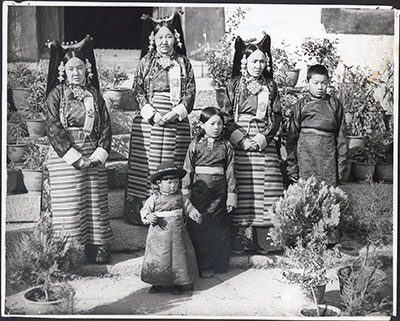
1998.131.479.1 (Print black & white)


1998.131.479.1 (Print black & white)

Frederick Spencer Chapman
Frederick Spencer Chapman
September 14th 1936
Mary Taring, Pema Dolkar, Tsarong, Norbu Yudon
Lhasa > Tsarong House
1998.131.479.1
196 x 247
Print gelatin silver
Donated 1994
Mrs Faith Spencer Chapman
British Diplomatic Mission to Lhasa 1936-37
Frederick Spencer Chapman
C.9.2 [view film roll]
SC.T.2.479
BMR.86.1.9.1
Notes on print/mount - 'Mrs Spencer Chapman' has been written on the back of the print in black ink. The number '201' has been written on in pencil, then deleted and replaced with '290' [MS 28/03/2006]
Manual Catalogues - Caption in Chapman's hand-written list of negatives made whilst on the Mission to Lhasa, 1936-7 [See PRM Manuscripts Collection]: 'Tsarong’s family on steps [of Tsarong’s house]'; PRM Manuscripts Collection: ‘List of Tibetan Prints and Negatives’ - Book 2: ‘ “Rogues Gallery” - 39/2 - Tsarong’s womenfolk outside his mansion. On left Mary Tering (Jigme’s wife) then Tsarong’s wife and Mrs Dele Rabden and her children’ [MS 28/03/2006]
Exhibition - This image appeared in the 2003 Temporary Exhibition at the Pitt Rivers "Seeing Lhasa: British Depictions of the Tibetan Capital 1936-1947"
Research publication - Clare Harris and Tsering Shakya (eds.), 'Seeing Lhasa: British Depictions of the Tibetan Capital 1936-1947', Chicago: Serindia Publications, 2003, p. 54-55.
Biographical Information - From left to right: Rinchen Dolma “Mary” Taring, Pema Dolkar, Norbu Yudon with various children. The three women are sisters, daughters of the late Tsarong who was killed along with his son for alleged support of the Chinese army that invaded in 1910. Tsarong shappe took over as head of the family marrying the son’s widow Rigzin Choden. However, the people of the Tsarong estate worried that this might mean the end of the bloodline and so Tsarong also married the eldest daughter Pema Dolkar. He later also married Rinchen Dolma and a younger sister (not seen here) Tseten Dolkar, the widow of another Tibetan aristocrat, Horkhang. Norbu Yudon was married into the Dele Rabden family. British reactions to these women were varied: Rinchen Dolma was said to speak perfect English, Mrs Dele Rabden was described as distinguished looking but shy and Pema Dolkar as the perfect hostess. According to the photographer, Spencer Chapman the children were “most delightful-quite unspoiled, and full of life and intelligence” (1938:107) [CH 2003]
Other Information - Related Images: Images prefixed with 'C.9' comprise a group of negatives containing images of Tsarong’s family and his house, a Tibetan stove, preparing paint for Potala and camels. The date is not certain, but it seems most likely that these images of Tsarong and his family were taken on September 14th when dinner was held there on the occasion of the departure of Brigadier Neame [MS 28/03/2006]
Other Information - Description: "The door [of Tsarong's house] is ornamented in the best Tibetan style, but in front of it are a dozen granite steps covered with pots of flowering plants" ['Lhasa: The Holy City', F. Spencer Chapman, London: Chatto & Windus, 1938, p. 104] [MS 28/03/2006]
Other Information - Description: "In most Tibetan houses, except perhaps Ringang's, we had to be on our best behaviour, but Tsarong's parties were always completely riotous, especially when his three children came home from school. ... // After tea the Dele Rabdens came in. ... His wife is very distinguished-looking and has a quiet shy manner. // All three women were dressed in the complicated and resplendent finery of the Lhasa lady of fashion. The glossy black hair is parted in the middle and brushed down at the side to cover the ears. At the back it is neatly tied in two long plaits. The parting divides on the crown of the head so as to run each side of a small patch of hair as big as a penny, then unites again. The hair from this isolated portion is made into a small plait which covers the parting down the back of the head. Two heavy gold ear-rings set with large pieces of turquoise are hung from the hair above the ears, effectively framing the oval face. On the back of the head is worn a concave triangular crown closely covered with strings of seed pearls and further ornamented with a row of corals the size and colour of cherries. False hair is suspended from each side of the crown; it hangs loose to begin with and is then plaited with a red tassel so that it almost reaches the ground. ... // It was at Tsarong's house that we first met Tibetan children, whom we found most delightful - quite unspoiled and full of life and intelligence" ['Lhasa: The Holy City', F. Spencer Chapman, London: Chatto & Windus, 1938, pp. 106-7] [MS 28/03/2006]
For Citation use:
The Tibet Album.
"Tsarong's' family at home"
05 Dec. 2006. The Pitt Rivers Museum.
<http://tibet.prm.ox.ac.uk/photo_1998.131.479.1.html>.
For more information about photographic usage or to order prints, please visit the The Pitt Rivers Museum.
© The Pitt Rivers Museum